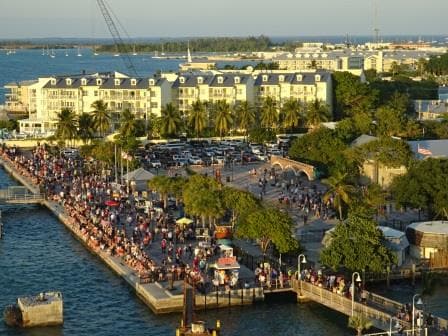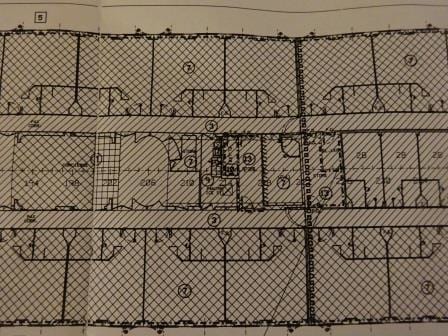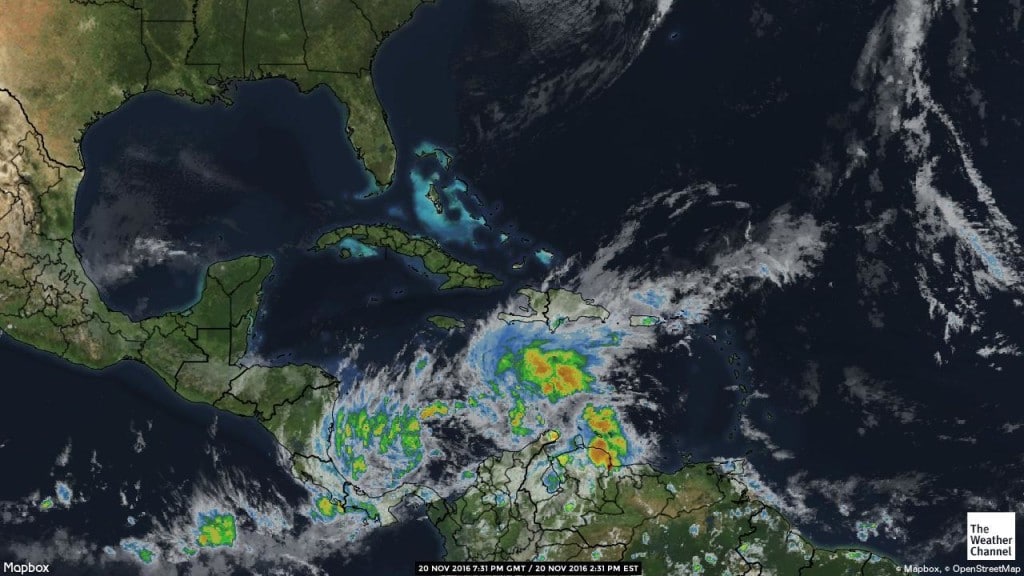We had indeed to wait until our official departure time of 1800 hrs. and even passed it. Although sunset was at 17.39 hrs. it took some time for all the sunset watchers to digest the sunset and wander off and it took some time to get the last straggler back on board. Key West was a busy as ever and Mallory Square must have been heaving if all who came for the sunset also stayed around for a while.

I always wonder if these people do not have a sunset at home to look at. Maybe not if you live in the Big City.
Today we are in between Key West and Roatan and we managed to get passed Can San Antonio safely around noon time. I use the word safely as there can be a lot of traffic there, as every ship which goes to the south or to the north here tries to get around the west point of Cuba in the most efficient way. Which means with the sharpest course lines possible. If you are not calling at a Cuban port you have to respect the 3 mile coastal zone and stay out of it and thus every ship would be curving around here at 3.1. Nautical miles from the coast if it got the chance. (Approx. 3.5 land miles) This gave in the past cause to a number of collisions and thus the IMO laid out vessel traffic separation (VTS) zones to keep north and south bound flow apart. When you now go northwards you sail approx. 4 to 5 miles off the Cuban coast and southbound it is about 10 miles. And then there is a no-go zone between the two lanes. There can still be a problem when you enter and leave the traffic lanes if there is a more creative navigator who decides then to “cut across” by following the most convenient course line from the VTS, to wherever he or she is going. But in general things have improved here dramatically.
We did not have any issues and thus we entered safely the Yucatan channel which turned out to be a lot windier than originally forecast. A fresh North easterly breeze is now pushing us into the Caribbean Sea and as it is a following wind, the relative wind on deck is very gentle and thus everybody is happy today.
After a complete survey of the ship, I have embarked on my next project that will keep me going for a while. Store room management and Space categorization. And I think that needs some explanation. When a ship is constructed various areas on board are protected in different ways against fire and other mayhem. The insulation and steel strength around the engine room spaces is different than around guest cabins. Also the pantries where liquor or combustibles could be stored are constructed in a different way than area’s which store buckets and or paper work. Then there is sound insulation to a varying degree and the need of fire suppression or not. Construction rules classify each space on a listing from 1 to 14, with category 14 being the most heavily protected space.

A bit of a boring picture but this is the “roof” or under decks of the Neptune Lounge and surrounding cabins. All the spaces have a different number indicating what can be stored in there and what the protection level is. A cabin is a 7, a general store a 13, meaning you can store more flammable material in a 13 then in a 7.
That is all done at the shipyard and verified by the Classification society, in our case Lloyds Register. But then the ship starts sailing and the lockers are filled up with anything you can think of. Sailors are real hoarders as it is not always easy to get items on board that you know you will need again one day and thus will not discard. Lockers start filling up with items which sometimes should not be there. Then there are dry – docks and the modifications are carried out. Structural modifications have to be approved and normally are. But dry dock people can be very creative and are also very good in “circum navigating” the normal procedures if it reduces time. Thus our main office Carnival Corporation has come up with a “Store Room Management Policy” to ensure that by regular checking everything remains as required and remains safe.
Why does it involve me: Because it deals with a myriad of rules and regulations, past experience and authority needed to enforce changes if needed. If a captain speaks up, everybody listens, if it is a less senior officer, endless arguments ensue as nobody wants to move items, or heaven forbid, discard something. Part of the new policy is that every place where something can be stored will receive a sign which in general states what is allowed in the space and what is not. It will not say how it has to be stored, apart from safely stored that will be the decision of the inspector and evaluator.
Not that I am expecting many challenges. During my inspections on the crossing I found the ship in an excellent shape; now it is time to review compliance not with the spirit of the rule, but with the letter, the dot and the comma.
Tomorrow we are in Mahogany Bay Roatan. We will be at the pilot station and 07.00 hrs. and then sail astern (backwards) into the bay for about half a mile and then dock at the south pier. Behind us at the north pier will be / is scheduled to be, the Seven Seas Mariner. Weather for tomorrow: Partly Cloudy, 81oF / 27oC. with a moderate breeze. Yesterday the forecast was still rain but it looks that a developing Otto is pulling all the moisture towards the forming center.
The weather gurus are still hedging their bets, but the language is getting more ominous.
A broad area of low pressure north of Panama, labeled 90L, will remain fairly disorganized today with a scattering of showers and thunderstorms around the low’s center of circulation. The environmental conditions for tropical development of this low will become more favorable during the next 24-48 hours and it may become a tropical depression early this week. If this system were to organize into a tropical storm, it would take on the name of Otto and threaten Central America late next week.


Leave a Reply